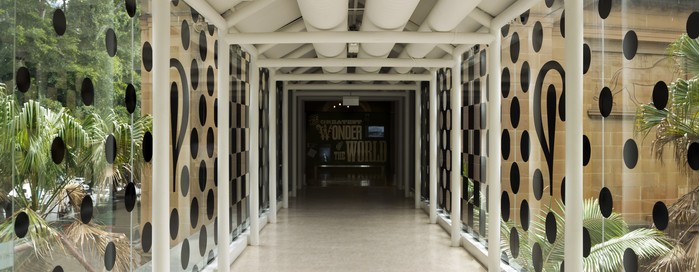
Glass bridge and external frieze
1942
Frieze by M Swan, O H Dutton, F MacGowan and O Stein of Beat Brothers
1988
glass bridge by Andrew Andersons
Frieze by M Swan, O H Dutton, F MacGowan and O Stein of Beat Brothers
1988
glass bridge by Andrew Andersons
The elevated glass bridge connects the Mitchell and Macquarie Street buildings. From here, the first segment of the frieze that continues along the southern side of the Mitchell Wing can be seen at relatively close range. This series of nine panels carved in sandstone was added to the building in 1942 to reference images found in the Library’s collection.
Carefully selected by the Library’s research team, the scenes are drawn from the religions, philosophies and arts of past civilisations. The first four carvings also represent the birthplaces of the earliest-known written languages: Egypt with the lion, Sumeria with the Assyrian winged bull, China with the warhorse and phoenix, and (obscured by the palm trees) India with guardian peacocks flanking a Tree of Life. The remaining panels can be seen from the paved terrace below, which curves around the skylight of the Glasshouse learning space to connect Macquarie Street to the Domain.
Also visible from the bridge are the extensions made to Parliament House by government architect Andrew Andersons and completed in 1985. Andersons was also the architect of the Library’s Macquarie Street building, completed in 1988.


 Back to list
Back to list